Friday Apr. 6, 2007
The quiz papers were returned in class today.
An in-class optional assignment was distributed in class. The
assignment will be collected at the beginning of class on Monday.
The notes below were hurriedly put together Friday afternoon and
haven't yet been carefully proofread.
We'll
spend about a week in Chapter 6 learning about the forces that cause
surface and upper level winds.
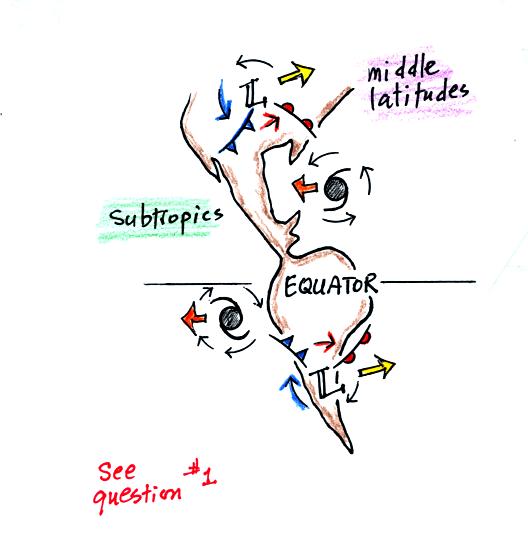
You can't leave NATS 101 Intro. to Weather and Climate
without
having been introduced to the Coriolis Force. It is part of the
reason why winds spin counterclockwise (CCW) around Low
pressure
and clockwise (CW) around High pressure in the northern
hemisphere. It is also causes winds to spin in the opposite
directions around Highs and Lows in the southern hemisphere.
You may already have been
to the southern hemisphere or you may go there one day (see Question
#11 on the In-class Optional Assignment). You'll
probably hear about how the Coriolis force or the Coriolis effect
causes water to spin in a different direction in the southern
hemisphere when it is draining out of a sink and toilet bowl (it's not
true).
That's another reason for covering the Coriolis effect in NATS
101.
Before
learning about some of the other forces that cause or affect the wind
we need to review Newton's Laws of Motion.
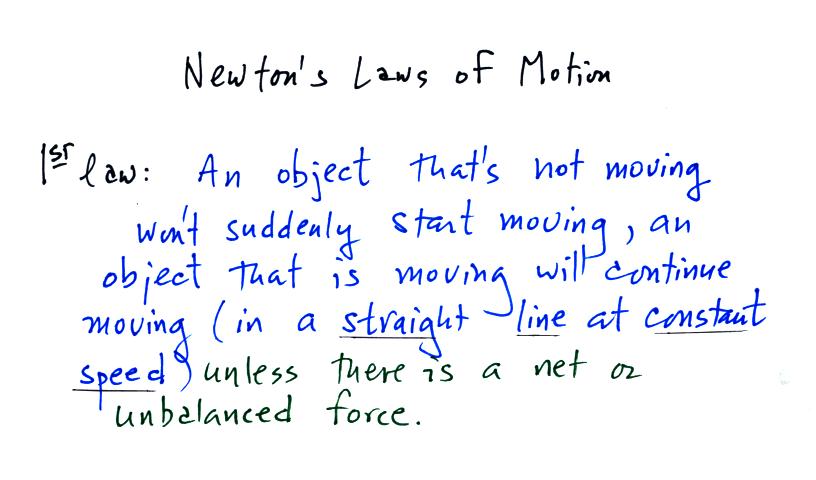
The 1st law really has two parts: one that deals with
stationary
objects and another part that treats moving objects.
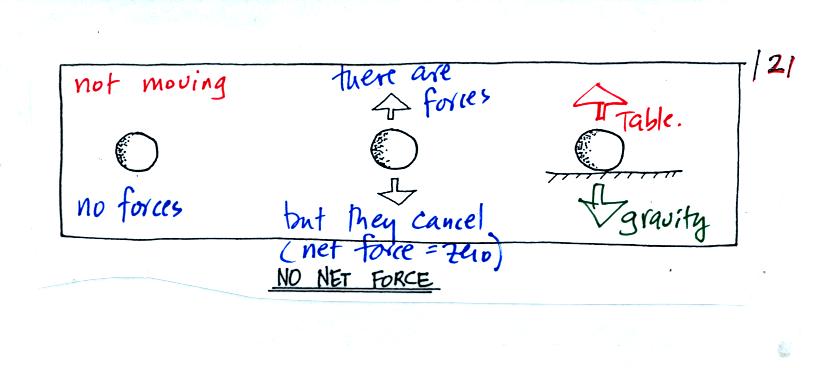
A stationary object is shown in all three figures
above (found on p. 121 in the photocopied Class Notes). In
the left example there aren't any forces at all being exerted on the
object, there is no reason for it to suddenly start to move. In
the middle and right examples there are two forces present but they are
of equal strength and point in opposite directions. They cancel
each other out and the net or total force is zero. Again the
stationary object won't suddenly begin to move.
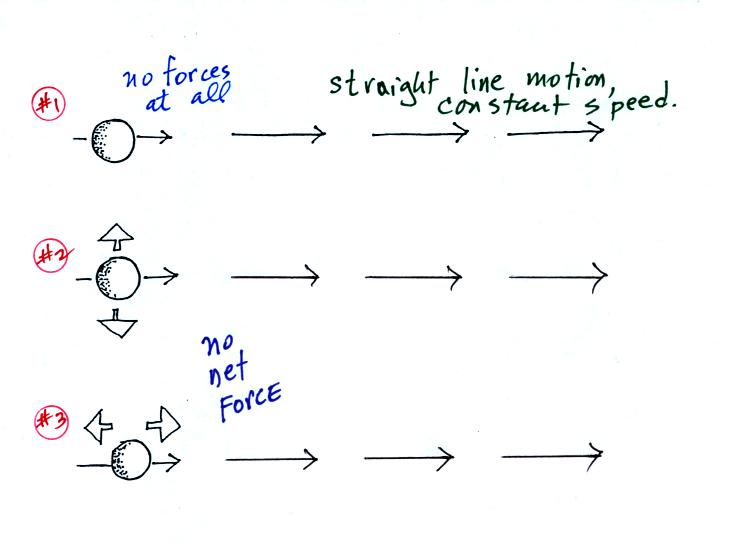
In the first example above there aren't any forces at
all. In Examples #2 & #3 and #4 & #5 below (on p. 121 in
the photocopied notes) the
next force is zero (the two forces present cancel each other
out). The object will continue to move in a
straight line at constant speed (the thin arrows show the direction of
motion, the length of the arrow provides an idea of speed.
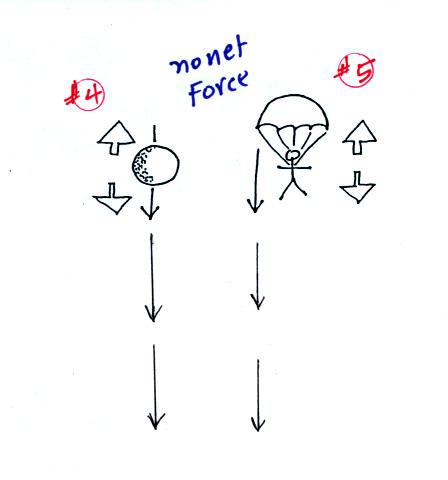
We are used to seeing falling objects pick up speed as they
fall. But if an upward drag or friction force becomes strong
enough to balance the downward pull of gravity and the net force is
zero, the object will fall at constant speed. Parachutists take
advantage of this.
Next
we will look at the motion that occurs when a net force is
present. You should be able to look at the motion and determine
whether a net force is needed.
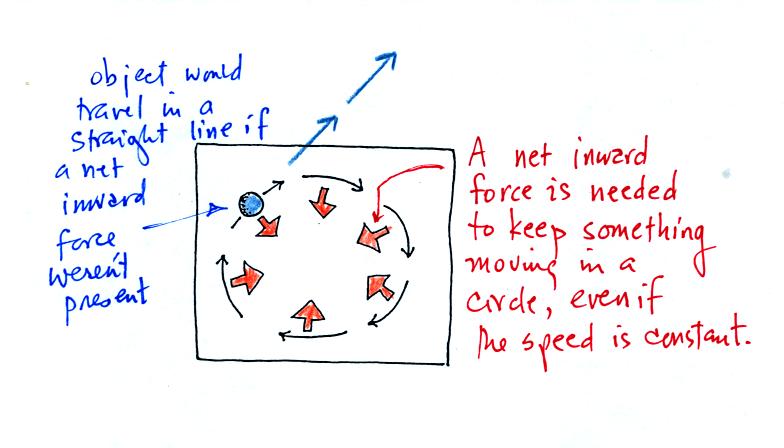
If there were no net force at the point indicated,
Newton's 1st law of
motion would say the object would travel in a straight line at constant
speed (the blue arrows). But the object turns to the
right. A force acting perpendiculary and to the right of the
object's direction of motion are needed. A net inward force is
needed to keep an object moving in a circular path.
An example would be a satellite orbiting the earth

Gravity supplies the net inward force needed to keep the
satellite in a
circular orbit.
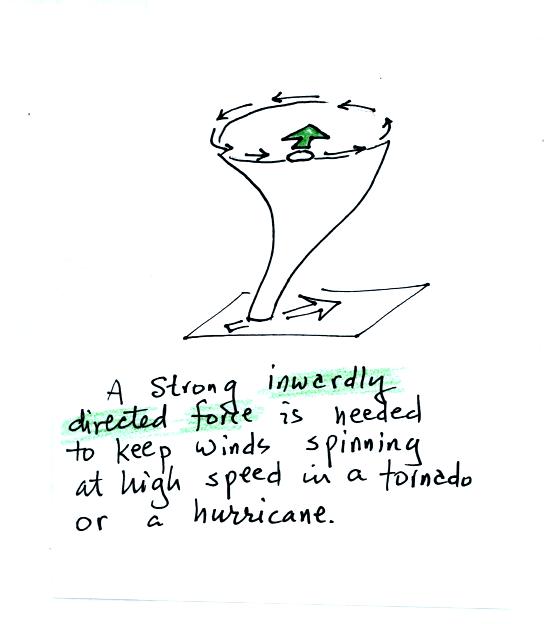
In the case of the rapid winds in a tornado, a very
strong inward force is needed (it turns out to be the pressure gradient
force
(PGF) or pressure difference force).
What we will be most interested in are the upper level winds which, if
you remember from earlier in the semester, blow parallel to the contour
lines on an upper level chart from west to east.
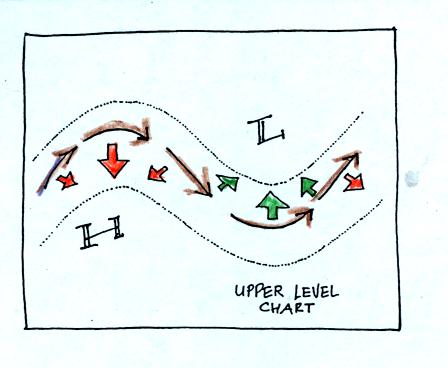
Note that the net force is sometimes to the right of the wind and
sometimes to the left of the wind.
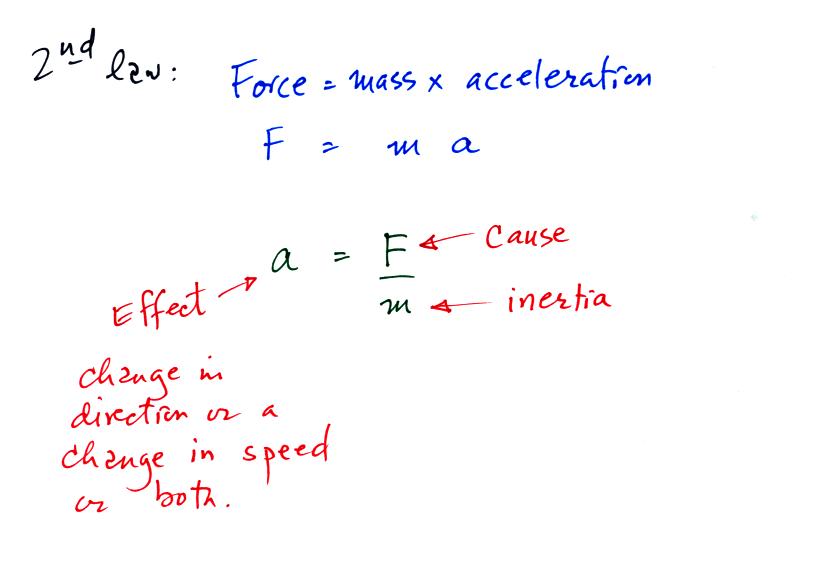
The 2nd law of motion really just says that if you exert a
net force on
an object it will accelerate. Acceleration can mean starting to
move, speeding up or slowing down, stopping, or starting moving in a
different direction.
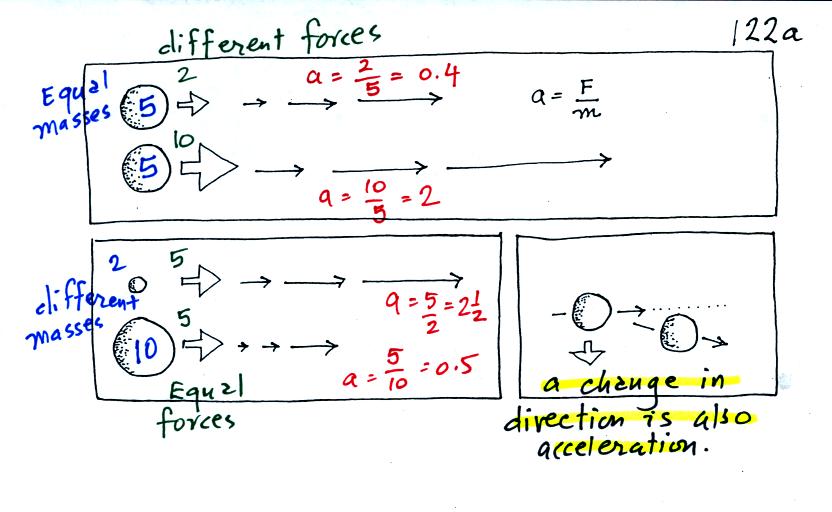
In the first example unequal forces (2 and 10) are applied
to
equal
masses (5 and 5), don't worry about the units. You
can calculate the acceleration
by dividing force by mass. This gives you the acceleration, the
lower object will speed up five times faster than the top object which
has a weak force exerted on it.
In the bottom example equal forces (5 and 5) are applied to two
different masses (2 and 10). Mass can be thought as being
inertia, or resistance to change. An object with a large mass is
resistant to a change of
direction or speed. A large object is harder to start moving than
a small object (imagine pushing a stalled Volkswagen and a stalled
Cadillac out of an intersection). The large mass accelerates 5
times more slowly than the smaller mass. Once the large mass gets
up to speed however, is is hard to slow it down (a decrease in speed
with time is a form of acceleration, we usually call it deceleration)
Note that a change in direction, with or without a change in speed, is
also a form of acceleration.

The first two forces above determine upper level winds; we'll study
them first. For surface winds you must include the frictional
force.
Next we will try to understand what causes these forces. That's
pretty easy with the pressure gradient and frictional force, not so
easy with the Coriolis force. In each case we will learn rules
that determine the direction and the strength of these forces.
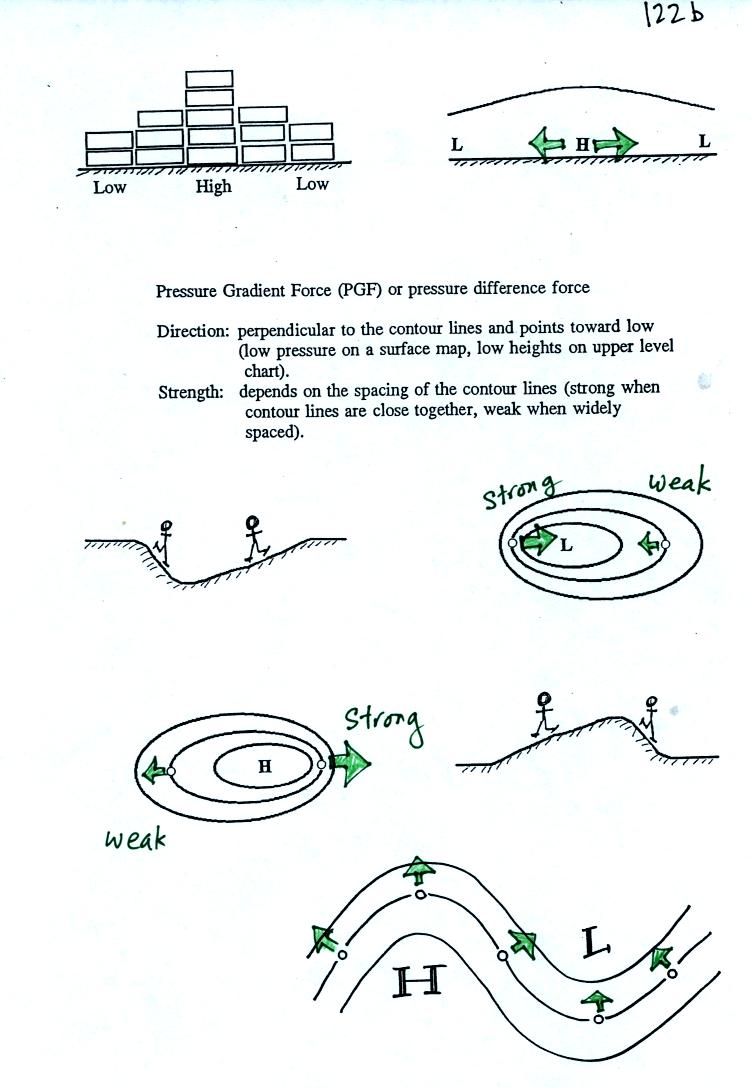
Pressure at any level in the atmosphere is determined by the
weight of the air overhead. If you stack up a bunch of bricks as
shown at upper left it is easy to understand that the pressure at the
bottom center of the picture would be higher than an the edges.
Now imagine carrying a bucket of water to the center of a swimming pool
and pouring it out on the water that is already there. You
wouldn't be able to pile up water at the center of the pool. As
soon as you tried the higher pressure at the bottom of the pool would
cause water to flow. The same kind of thing happens with
air. The pressure difference force pushes air from high to low
pressure.
The rules used to determine the direction and strength of the PGF are
given in the center of the picture.
Some examples of PGF force directions and relative strengths
are shown
at the bottom of the figure. Note the analogy between weather
maps and geographical features like hills and valleys.
The pressure gradient force can cause stationary air to begin to blow
(there is nothing in the rule that says the strength of the PGF depends
on wind speed).
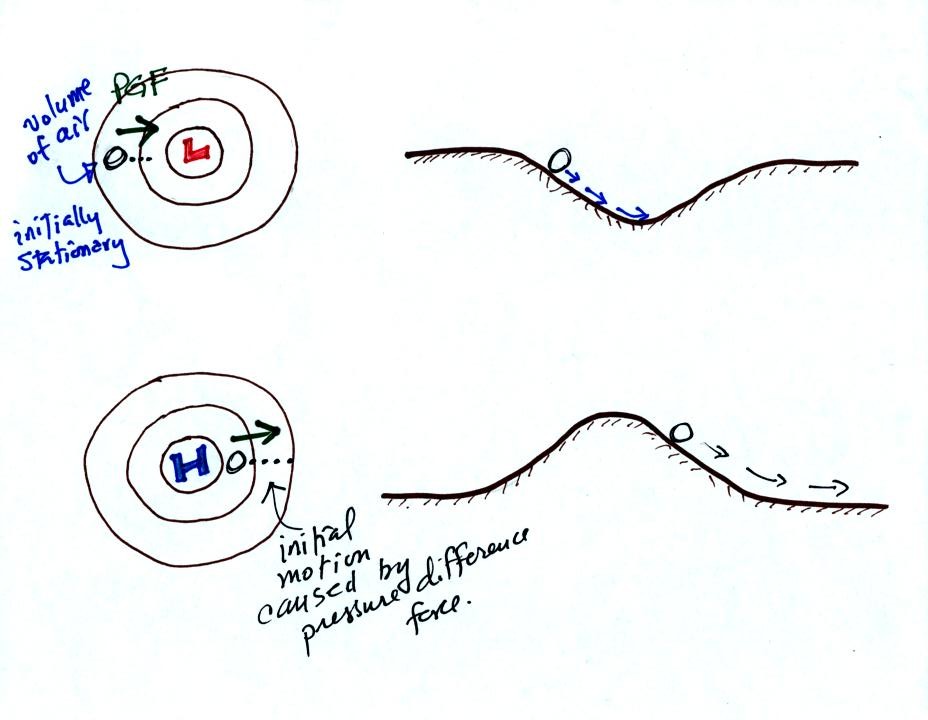
In the top
example a stationary volume of air is placed in a center of low
pressure. The PGF will cause the air to begin to move toward low
pressure in the center of the picture. The dotted line shows the
direction of initial motion. This like placing a ball on the side
wall of a valley. The ball will roll downhill.
In the second example, a center of high pressure, the PGF causes a
stationary volume of air to again begin to move toward low pressure
which is outward and away from high pressure. In the analogy a
ball placed on the side of a hill will roll downhill and away from the
summit.
So given a pressure pattern you should be able to determine the
direction of initial motion. The initial motion will always be in
the direction of low pressure.
Now on to
the Coriolis force.

You'll find the figure above on p. 122c in the photocopied Class
Notes. Imagine something flies over Tucson. It
travels
straight from west to east. The next figure shows the path that
the saucer followed as it passed over the city.

The flying saucer appeared (relative to the ground) to be
moving in a
straight line at constant speed. You would conclude that there
was zero net force acting on the flying saucer.
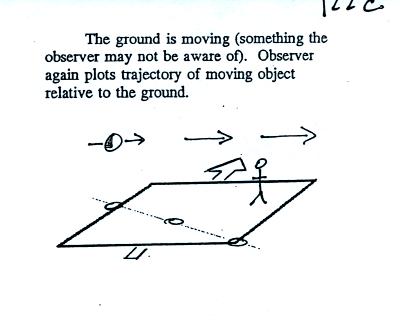
In this second picture the flying saucer flies by overhead
just as it
did in the previous picture. In this picture, however, the ground
is moving (don't worry about what might be causing the ground to move).

This is the path that you would see relative to the ground
in this
case. Even though the flying saucer flew from west to east it
appears to have been traveling from the NW toward the SE because the
ground was moving as the flying saucer passed overhead. Because
the motion is still in a straight line at constant speed, you would
conclude the net force acting on the flying saucer was zero.

In this last figure the flying saucer flies by again from
west to
east. In this case however the ground is rotating.
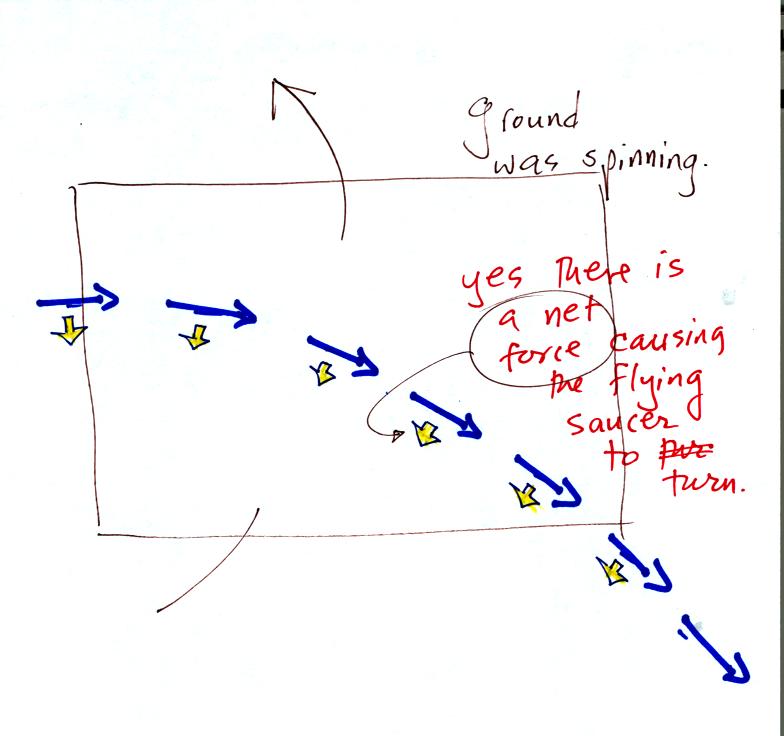
Now the flying saucer appears to have been turning to the
right as it
passed over Tucson. Because it is no longer traveling in a
straight line you would conclude there was a net force acting on the
flying saucer. The direction of this net force would be to the
right of the motion.
At most locations on the earth the ground is rotating. This is
most easily seen at the poles.
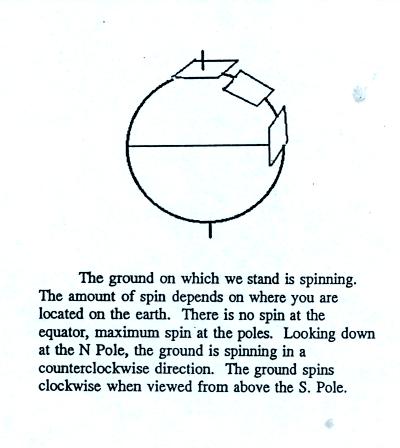
Imagine a piece of paper glued to the top of a globe.
As the
globe spins the piece of paper will rotate. A piece of paper
glued to the globe at the equator won't spin, it will flip over.
At points in between the paper would spin and flip, the motion gets
complicated.
The easiest thing for us to do is to ignore the fact that the ground on
which we are standing is rotating. However, if we do that we need
to account for the curved paths that moving objects will take when they
move relative to the earth's surface. That is what the Coriolis
force does.

Here are some rules that you can use to determine the
direction and
strength of the Coriolis force (whether you understand what causes it
or not). It always points in a direction
that is perpendicular to the wind, it can't cause the wind to speed up
or slow down, it will only change the wind's direction.

The red arrows show the direction of the CF in the northern
and
southern hemispheres. The CF is to the right of the wind (you
need to look in the direction the wind is blowing, you need to look
downstream) in the northern hemisphere and to the left of the wind in
the southern hemisphere.























